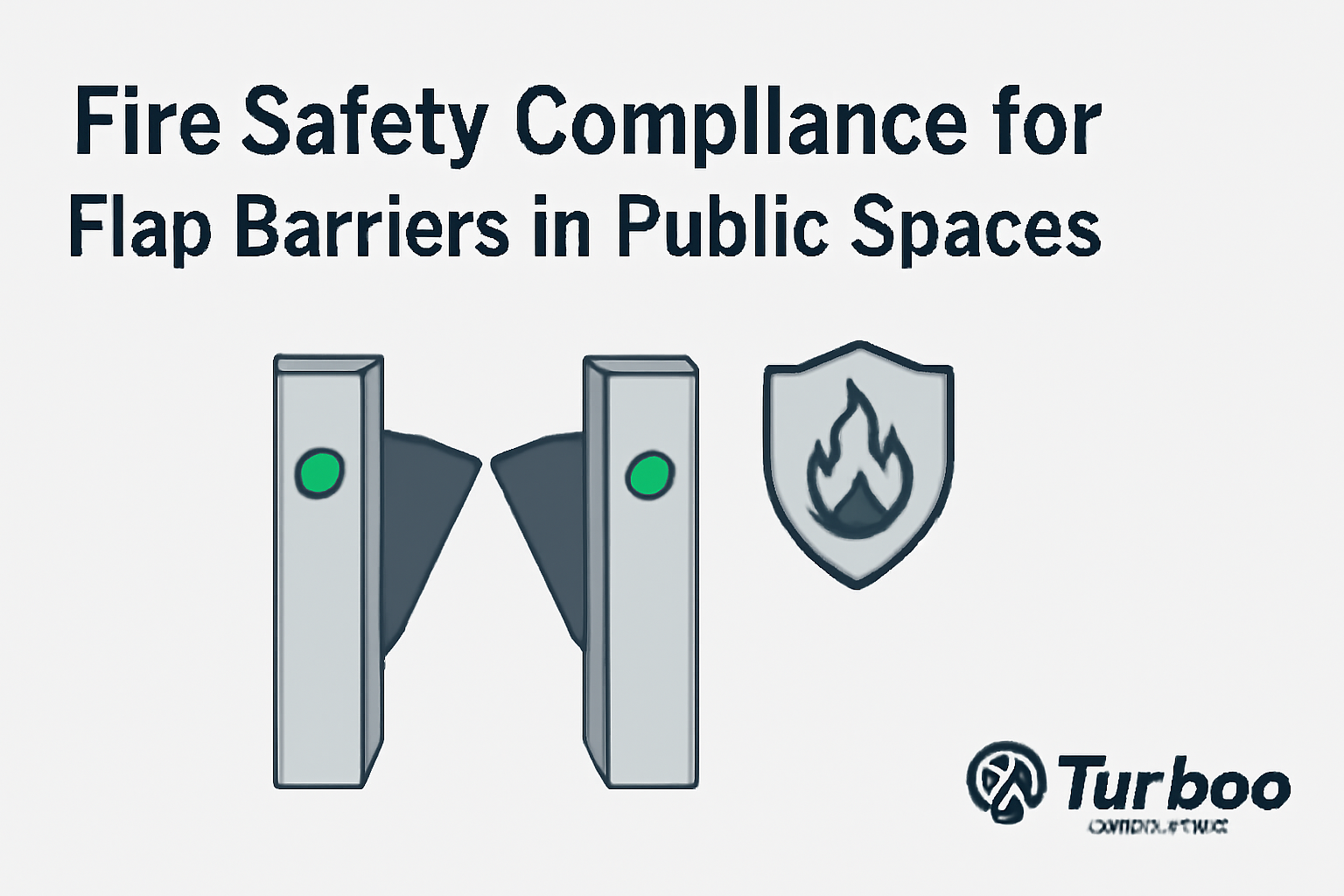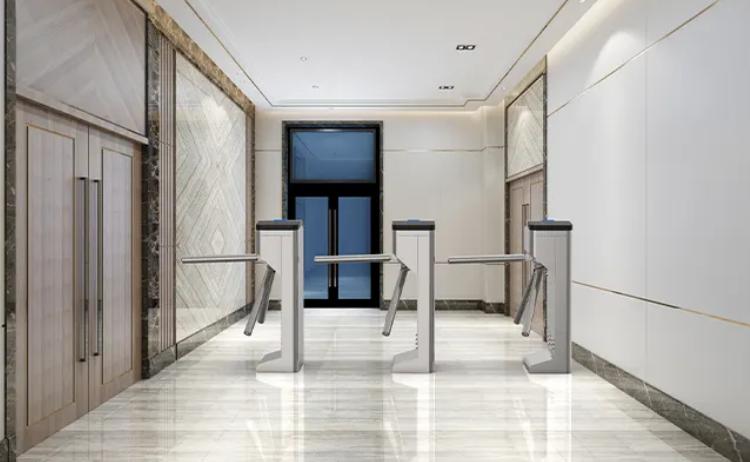Fire Safety Compliance for Flap Barriers in Public Spaces


Fire safety is a top priority when installing flap barriers in public areas. Many facilities risk serious consequences if their access control systems do not meet fire safety standards. This article explains essential fire safety rules that apply to flap barriers. Readers will learn how to ensure their installations follow all required regulations. Clear guidance on compliance helps protect people and property while avoiding legal issues.
Importance of Fire Safety in Access Control for Public Spaces
When it comes to flap barrier fire safety, the primary concern is always human life. In locations such as transit hubs, stadiums, and convention centers, the sheer volume of foot traffic makes any delay in an emergency evacuation potentially catastrophic. Flap barriers serve as both security checkpoints and flow regulators, but under fire conditions these very gates can become hazards if they aren’t engineered and installed correctly. Beyond the immediate risk to occupants, compromised exit routes can hamper first-responder access, delaying critical firefighting efforts.
Furthermore, aligning access control measures with broader public safety regulations reinforces an organization’s commitment to proactive risk management. A facility that meticulously plans its emergency evacuation routes—factoring in the presence of flap barriers—reduces liability and builds trust among patrons and staff alike. In fact, integrating safety into everyday operations demonstrates compliance with insurers’ requirements and can lead to lower premiums over time. Ultimately, viewing flap barriers not merely as security hardware but as integral components of a comprehensive fire safety strategy is essential for any facility manager or safety officer tasked with protecting both people and property.
Key Fire Safety Regulations Affecting Flap Barrier Installations
Navigating the landscape of fire safety compliance demands familiarity with multiple layers of legal and technical standards. At the national level, the NFPA 101 Life Safety Code sets forth minimum requirements for means of egress, emergency lighting, and door hardware—criteria that directly impact flap barrier selection and placement. Meanwhile, local jurisdictions may impose additional mandates on barrier construction, clearance dimensions, and panic hardware specifications. It is imperative to cross-reference both sets of requirements to ensure no gap in coverage.
To streamline this process, many professionals turn to dedicated resources that compile relevant regulations. By consulting manufacturer guidelines alongside official code books, planners can rapidly validate that a chosen flap barrier model accommodates the required line-of-sight, clearance width, and fail-safe operating modes. Moreover, periodic changes to building and fire codes—often driven by emerging data on crowd behavior and new materials—necessitate an ongoing review cycle. Proactive coordination with local fire marshals and building officials will help identify upcoming amendments before they affect project timelines or force expensive retrofits.
The Role of Certifications in Demonstrating Compliance
Securing the proper certifications is a critical step toward verifying that a flap barrier meets established safety benchmarks. Accredited bodies such as UL (Underwriters Laboratories), FM Global, and various European CE authorities test access control devices under simulated fire-alarm conditions to ensure reliable release mechanisms, battery backup performance, and resistive properties. A certified flap barrier carries documented proof that it will default to an unlocked position upon alarm activation, thereby preventing entrapment during an evacuation.
When evaluating products, demand full test reports and factory inspection records. Reliable vendors will supply comprehensive dossiers covering initial type testing, periodic re-inspections, and component traceability. In many regions, certification must be renewed every few years, reflecting changes in technology and updated testing protocols. Staying current not only satisfies regulatory audits but also reinforces operational readiness. For details on maintaining valid certifications, facility managers should establish a compliance calendar and budget for annual or biennial recertification fees.
Integration of Flap Barriers with Emergency Exit Requirements
Properly designed flap barriers do more than block unauthorized entry—they integrate seamlessly with a facility’s emergency exit network. Modern systems incorporate panic-release buttons, break-glass units, and power-fail overrides that instantly retract the barrier upon alarm. Such features must interface directly with the building’s fire-alarm control panel so that a manual or automatic alarm triggers all connected access points simultaneously.
To verify this integration, conduct full-scale drills in coordination with your local fire department. Observations during these exercises often uncover unexpected interlocks or latency in barrier response. Any delay—even fractions of a second—can create bottlenecks when hundreds of people are seeking egress. In addition, reviewing manufacturer installation guides against the jurisdiction’s fire codes and FEMA’s safety guide ensures that the technical setup aligns with recommended best practices for emergency lighting, signage, and audible alarms.
How to Ensure Flap Barriers Do Not Obstruct Evacuation Routes
A flap barrier that functions flawlessly in normal operation can become an obstruction if its location or maintenance is neglected. To prevent this, plan barrier placement well clear of main egress corridors and stairwells, allowing for the full swing of panic-release panels without impeding foot traffic. Visual wayfinding—using high-contrast floor markings and illuminated exit signs—guides occupants toward the nearest barrier release point in low-visibility conditions.
Regular inspections are equally important. Dust, debris, or mechanical wear can slow barrier movement, increasing the time needed for complete retraction. Establish a routine inspection schedule, checking that sensors are unobstructed and that lubricants are applied according to the manufacturer’s specifications. Training frontline staff to recognize early warning signs—such as unusual noises or delayed response—can trigger timely maintenance before an emergency occurs. In doing so, you reinforce a culture of proactive safety rather than reactive repair.
Consequences of Non-Compliance Including Safety Risks and Legal Penalties
Overlooking flap barrier fire safety can trigger a cascade of adverse outcomes. In the worst-case scenario, an access control device that fails to unlock promptly in a fire can trap occupants behind locked gates, leading to injuries or fatalities. Beyond human toll, first responders may struggle to breach locked barriers, delaying firefighting efforts and increasing property damage. In fact, NFPA 101 explicitly warns that any obstruction of a required egress path constitutes a life-safety violation and must be corrected immediately to comply with fire codes.
Financially, the stakes are equally high. Municipalities and insurance carriers impose hefty fines on facilities found in violation of local fire regulations. A single incident of non-compliance can result in penalties ranging from thousands to tens of thousands of dollars per day until the issue is remediated. In addition, if a trapped individual suffers harm, the facility operator may face civil lawsuits for negligence—an exposure that can escalate into multimillion-dollar judgments.
Finally, regulators have the authority to shut down operations until full compliance is achieved. For public venues like airports or stadiums, even a brief closure inflicts severe reputational harm and loss of revenue. Fully understanding these consequences underscores why maintaining ongoing compliance isn’t just a bureaucratic checkbox—it’s a core component of operational risk management.
Safety Risks of Flap Barrier Failures
When flap barriers malfunction during an emergency, the hazards extend well beyond simple inconvenience. Sudden jamming or partial retraction can create sharp edges at ankle or waist level, causing trip-and-fall injuries in panicked crowds. In low-visibility conditions—smoke, flashing lights, or power fluctuations—disoriented evacuees may collide with partially open gates, resulting in bruises, fractures, or worse.
Erratic sensor behavior represents another risk factor. If optical or pressure sensors become misaligned or obscured by debris, the barrier may retract unpredictably or refuse to open at all. Such failures undermine the reliability of the entire exit network. To guard against this, facilities should follow NFPA’s recommendation for monthly functional testing of all egress-linked devices and replace worn components according to the manufacturer’s maintenance schedule.
Moreover, power-fail scenarios demand special attention. A flap barrier that lacks a dedicated emergency power supply—or whose battery backup is past its service life—can remain locked in place when the main utility line fails. Integrating a fail-safe backup and verifying its readiness through periodic load tests ensures that, in the critical seconds of a real fire, the barrier will default to a fully open state rather than compounding the hazard.
Legal and Financial Consequences for Non-Compliance
Regulatory bodies wield significant enforcement powers when it comes to fire safety violations. Under many jurisdictions’ fire prevention codes, failure to apply for requisite modifications or inspections before installing flap barriers is a punishable offense. Inspectors can issue stop-use orders, requiring immediate deactivation of non-compliant barriers until corrective actions are documented and approved—an outcome that may force a facility to resort to manual crowd control, increasing labor costs and security risks.
On the civil-liability front, lawsuits alleging wrongful death or personal injury can target both the facility owner and the installation contractor. Attorneys often scrutinize maintenance logs, alarm-integration reports, and certification records to establish negligence. Absent clear, up-to-date certifications and maintenance documentation, legal defenses grow tenuous, pushing settlements into the seven-figure range.
Insurance carriers also adjust premiums based on a facility’s loss history and compliance record. A documented code violation not only triggers immediate surcharge penalties but can lead underwriters to mandate third-party audits or even refuse coverage renewal. By contrast, demonstrating strict adherence to recognized regulations and standards such as those published by NFPA and FEMA significantly reduces risk profiles—and the associated cost of risk transfer.
Reputational Damage and Insurance Implications
Brand integrity matters as much as legal compliance. A publicized incident of trapped patrons or a mandated venue closure due to non-compliant flap barriers can erode trust among customers, event organizers, and insurers. Social media amplifies these incidents, often spawning negative headlines that linger far longer than the actual downtime. Organizations that invest in regular safety drills, visible signage, and transparent reporting build a reputation for reliability and care—assets that are difficult to quantify but critical in competitive markets.
Insurance underwriters notice public perception, too. High-profile safety lapses can prompt carriers to impose more stringent risk assessments, demand larger deductibles, or exclude certain perils from standard policies. Some may even require on-site visits by loss control specialists before offering renewal terms. Conversely, facilities that maintain impeccable compliance records often qualify for preferred risk programs, unlocking lower rates and streamlined claims processes if an incident does occur.
Ultimately, reputational resilience and favorable insurance positioning reinforce one another. By proactively aligning flap barrier installations with recognized emergency standards—referencing guidance from fema.gov/emergency—organizations demonstrate both operational excellence and a commitment to public welfare.
Practical Steps to Maintain Ongoing Fire Safety Compliance
Maintaining flap barrier fire safety is an ongoing effort that blends routine procedures with strategic reviews. Below is a practical roadmap facility teams can follow:
- Develop a Compliance Calendar
Map out all certification renewal dates, regulatory inspection windows, and internal audit milestones in a shared digital calendar. Align these dates with vendor support contracts to guarantee timely service visits. - Schedule Regular Functional Tests
Conduct monthly door-release simulations that trigger the building’s fire-alarm system, ensuring all linked flap barriers fully retract within the specified time. Document every test in a logbook or electronic maintenance system. - Perform Annual Third-Party Audits
Engage an accredited fire-safety consultant to perform a comprehensive review, including sensor calibration checks, battery backup load tests, and code-conformance assessments. Use their recommendations to prioritize upgrades or repairs. - Train Staff and Stakeholders
Host quarterly workshops for security personnel, maintenance technicians, and facility managers. Cover topics such as manual release procedures, alarm panel overrides, and emergency communication protocols. - Maintain Detailed Records
Archive installation schematics, manufacturer’s manuals, test reports, and inspection certificates in both physical binders and a secure cloud repository. This dual approach safeguards against data loss and facilitates rapid retrieval during audits. - Stay Informed of Code Updates
Subscribe to NFPA code-change bulletins and local fire marshal newsletters. Periodically review amendments to fire codes and FEMA guidelines to anticipate shifts in compliance requirements.
By systematically implementing these steps—and embedding them into everyday operations—organizations can ensure that their flap barrier installations not only meet current public safety regulations but remain robust against future legislative changes and technological advances.
Best Practices for Retrofitting Existing Flap Barriers for Fire Safety
Retrofitting a legacy flap barrier system to meet today’s fire safety standards begins with a thorough site assessment. First, conduct a comprehensive audit of current barrier locations, wiring diagrams, and control-panel interlocks to identify any deviations from published regulations. During this phase, measure actual egress widths and verify that each barrier can fully retract within the minimum time specified by NFPA 101. Any discrepancies—such as worn actuator springs or outdated sensor types—should be documented and triaged for corrective action.
Next, prioritize mechanical upgrades that enhance fail-safe performance. Replace single-point power supplies with dual-feed or redundant battery backups, ensuring that a loss of primary power triggers instantaneous barrier retraction. Where feasible, install local manual-release overrides—such as break-glass stations—so that occupants or responders can quickly free any jammed barrier in an emergency. To support ongoing diagnostics, integrate self-test modules that sound audible alerts if the barrier fails to complete a monthly self-check cycle.
Visual and tactile feedback also plays a crucial role. Retrofit projects should include high-visibility exit signage mounted directly above or beside each barrier, along with floor markings that guide evacuees toward the nearest release point in smoke-filled or low-light conditions. Finally, schedule a post-upgrade inspection with the local fire marshal to review the modifications, secure necessary permits, and obtain official sign-off. By systematically addressing electrical, mechanical, and human factors, facility teams can transform older flap barriers into fully compliant, life-safety–ready assets without the expense of wholesale replacement.
Technology Innovations in Flap Barrier Fire Safety
Advancements in sensor and control technology are revolutionizing how flap barriers contribute to public safety regulations. Modern systems now leverage Internet of Things (IoT) architectures to deliver real-time health monitoring: built-in edge processors track actuator torque, sensor alignment, and battery voltage, transmitting alerts to centralized building-management dashboards if anomalies exceed predefined thresholds. Such predictive-maintenance capabilities drastically reduce the likelihood of in-service failures, ensuring that every barrier responds reliably during an emergency evacuation.
Another significant innovation is the integration of wireless mesh networks. Instead of running new hard-wired alarm loops—which can be costly and disruptive—fire-alarm signals and barrier-release commands transmit over secure RF channels. This wireless approach accelerates retrofit timelines and provides automatic re-routing if any single node goes offline. Facilities can also tie in advanced occupancy-counting cameras or thermal-imaging sensors to modulate barrier behavior: for instance, temporarily widening lanes when crowd density spikes, then reverting to normal security settings once conditions normalize.
Battery technology has kept pace as well. Lithium-ion emergency packs now boast higher energy density and health-monitoring circuitry, supporting hundreds of full-cycle barrier releases before requiring a service replacement. When combined with solar-charged backups in outdoor or atrium installations, these power solutions ensure flap barrier fire safety even in extended utility outages. As standards evolve, vendors continually certify new modules against NFPA’s latest test protocols, so it pays to compare product roadmaps and select platforms designed for seamless firmware updates and emerging-code compliance.
Collaboration with Fire Safety Authorities and Emergency Planners
Ensuring robust fire safety compliance demands close coordination with local fire marshals, emergency planners, and first responders from the project’s inception. By inviting these stakeholders to review barrier installation plans—complete with wiring schematics, alarm-interface diagrams, and egress-route maps—facility managers gain invaluable insights into jurisdiction-specific nuances that generic code books may not capture. Early engagement also streamlines permitting, avoiding “surprise” rejection of critical design elements during final inspection.
Joint emergency drills further strengthen collaboration. Schedule at least annual evacuation exercises that simulate alarm activation, barrier retraction, and responder ingress. Observers from the fire department can then verify that flap barriers unlock within required time frames and that no hidden chokepoints exist. Feedback captured during these drills should be formally logged and incorporated into routine maintenance procedures. Such documented, iterative improvements demonstrate due diligence and can be presented during compliance audits to substantiate a proactive safety culture.
Maintaining open lines of communication also extends to sharing maintenance logs and certification renewals. Many authorities require proof of ongoing compliance, so integrating an online portal—accessible by designated fire-authority personnel—allows automatic upload of test results, battery-load data, and updated certifications. This transparency minimizes back-and-forth during inspections and accelerates sign-off on system modifications. Ultimately, treating fire marshals and emergency planners as partners rather than adversaries fosters a cooperative environment where safety innovations can be rapidly adopted and validated.
Cost–Benefit Analysis of Fire-Safe Flap Barrier Systems
Investing in fully compliant, fire-safe flap barriers entails both upfront capital expenditure and ongoing operational costs. However, a detailed cost–benefit analysis often reveals substantial long-term savings and risk mitigation. On the cost side, factors include purchase price of certified hardware, installation labor, integration with existing fire-alarm panels, and expenses for dual-power feeds or battery backups. Retrofitting existing units is usually 30–50% less costly than installing entirely new barriers, provided the structural supports and lane layouts remain sound.
Benefits accrue in several ways. First, insurers frequently offer premium discounts—sometimes ranging from 5% to 15%—for facilities demonstrating stringent adherence to public safety regulations. These savings can offset maintenance fees and certification renewals within as little as two years. Second, reducing the risk of litigation and business interruption protects against catastrophic loss: preventing even one fatality or large-scale injury in an evacuation can save tens of millions in potential damages and public relations fallout.
Moreover, compliant barriers enhance operational flexibility. Facilities equipped with advanced IoT-enabled systems can redeploy audit data for security analytics, optimizing staffing levels and access-control policies. This secondary value stream—improved throughput without compromising safety—translates to better user experience and higher revenue in venues such as transit hubs and cultural attractions. When all these factors are quantified, the return on investment for fire-safe flap barriers often exceeds industry benchmarks, making compliance a strategic, profit-protective decision.
Future Trends and Continuous Improvement in Flap Barrier Fire Safety
Looking ahead, flap barrier fire safety will evolve alongside broader trends in smart–building technology and regulatory convergence. One emerging area is the use of machine-learning algorithms to analyze years of barrier-performance data and predict component wear before it manifests as a service-call event. By applying these insights, maintenance teams can schedule part replacements during planned downtimes, eliminating unplanned disruptions and ensuring every barrier functions flawlessly when needed.
Global standardization efforts are also underway, aiming to harmonize minimum egress-width and fail-safe requirements across regions. As a result, manufacturers are designing modular barrier platforms with international approvals—reducing complexity for multinational operators. Sustainability will drive material innovation, with fire-retardant composites and recyclable alloys replacing heavier steel assemblies without sacrificing mechanical strength.
Finally, immersive training tools—such as virtual-reality evacuation simulations—will allow security officers and first responders to experience realistic failure scenarios in a risk-free environment. These exercises reinforce correct manual-release procedures and highlight latent design weaknesses before they impact a live event. By embracing continuous improvement—grounded in both data analytics and human-centered drills—organizations can stay ahead of code revisions and deliver the safest possible environment for all visitors.
Essential Fire Safety Compliance Tips for Flap Barriers in Public Spaces
- Adhere to Minimum Egress Widths: Confirm that every flap barrier lane meets or exceeds NFPA 101 clearance requirements for full-capacity evacuation.
- Obtain and Maintain Certifications: Install only UL- or CE-certified barriers and schedule renewals per manufacturer and jurisdictional mandates.
- Integrate with Fire-Alarm Systems: Ensure instantaneous barrier retraction on alarm activation through wired or wireless interfaces to the main panel.
- Install Fail-Safe Power Supplies: Use dual power feeds or battery backups, and perform load tests to verify emergency operation under utility failover.
- Provide Visual and Auditory Cues: Mount illuminated exit signs, floor-level wayfinding, and audible alarms at each barrier to guide occupants in low-visibility conditions.
- Conduct Regular Functional Testing: Trigger monthly and annual release simulations, logging results in an auditable maintenance system.
- Collaborate with Authorities: Involve local fire marshals and emergency planners in design reviews, drills, and documentation sharing.
- Leverage Predictive Maintenance: Adopt IoT-based sensors and analytics to forecast component wear and schedule proactive repairs.
- Perform Cost–Benefit Analysis: Quantify insurance savings, liability avoidance, and operational gains to support budget allocations for compliance.
- Stay Informed on Code Updates: Subscribe to NFPA and FEMA bulletins and review local amendments to adapt barrier configurations proactively.












